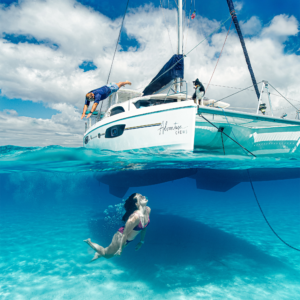If you ask me, dinner just seems to taste better when you catch it yourself, furthermore, it hardly gets any fresher than this. Bay scallops are a favorite dish here in Florida and are so much fun to hunt for and harvest. The season is open only a few months of the year and scalloping in Florida truly is the ultimate underwater scavenger hunt.
Scalloping is a great way to soak up the sun, stay cool, and enjoy a summer day in Florida. Can you say, hello adventure?
It’s also relatively inexpensive regardless if you rent a boat or bring your own.
My scalloping in Florida experience
The day started at 4:30 a.m., Cole and I wanted to get on the road early so we could get to Homosassa and the boat ramp before it got too crowded. Homosassa is a two-hour drive north. Scalloping season draws boaters from all over the state and the boat ramp and parking lot get crowded quickly.
Getting on the water
We made it to the Homosassa Public Boat Ramp without any issues. It’s located right by the Florida Cracker Monkey Bar on South Cherokee Way. We were on the water by 7:15 a.m. It was 75 degrees, foggy, and 97% humidity. Dare I say it was a little cool so I’m glad I brought a sweatshirt. We made our way down the Homosassa River and into the Gulf of Mexico. The fog was clearing and the sun was starting to come out by the time we got out into the Gulf. You want clear water when hunting scallops. An incoming tide is the best scenario for the clearest waters.
Getting in the water
We put up our dive flag and off we went. Cole found a couple of scallops right away. You have to look carefully as you’re swimming because they’re in plain sight but you’ll miss them if you don’t look closely. I found a few shortly after getting in the water. I dove down making sure not to get pinched as the scallop was closing. It doesn’t really hurt when the scallops pinch but it did startle me the first time it happened.
The best place to find them is in sea-grass beds. They like to hang out in the grass. I found them easier to spot if you swim against the current and look into the grass.
We hunted in several places nearby throughout the afternoon. When you find one, make sure to look around because there’s often more nearby within a couple of feet. We didn’t catch anywhere near our limit but we had a blast and made great memories. That’s what it’s really all about right?
What are bay scallops?
A scallop is a mollusk in a class known as bivalves. Basically what that means is that it’s a creature with a shell that has two halves. Bay scallops are relatively small so it takes a lot to make a decent meal. In fact, they’re about 3x smaller than sea scallops. You’ve probably seen sea scallops if you’ve ever been to a fine-dining seafood restaurant. Bay Scallops are not commercially harvested so you will not find them on a restaurant menu; however, they do tend to be a little sweeter tasting than sea scallops.
Bay scallops are bottom dwellers and you’ll usually find them in about 3-7 feet of water. They can grow to be 3.5 inches and live up to two years. However, in Florida, they rarely live longer than a year or grow bigger than 3 inches. They’ll probably see you before you see them because they have a lot of eyes. In fact, they have 30 blue eyes to be exact. When you dive down to grab one, they typically close from sensing shadows.

What you need to know before scalloping in Florida:
There are several things you need to know before throwing up the flag and jumping in the water. Scalloping season starts mid-summer and goes to the first of fall. There are certain limits to how many you can harvest and where you should look for them.
2023 Florida Scallop Season Dates:
Scalloping season dates vary by zones. Below are the Regional Bay Scallop Seasons:
- Gulf County Zone: August 16 – September 24
- Franklin – NW Taylor County: July 1 – September 24
- Fenholloway – Suwannee River Zone: June 15 – Labor Day
- Levy, Citrus, and Hernando counties: July 1 – September 24
- Pasco County zone: July 1 – August 6
The harvest zone map from the FWC can be found here.
Scalloping in Florida locations
- Homosassa Springs
- Steinhatchee
- Crystal River
- Horseshoe Beach
- Saint Marks
These are some of the popular scalloping locations along the coast. Crystal River is arguably the most popular spot for Floridians but my favorite is Homosassa with its long snake-like river. This area makes for great sightseeing of “Old Florida.”
Read more here: The best places for scalloping in Florida
Safety when scalloping in Florida
Safety should always be top of mind when diving for scallops! Anytime someone is in the water a dive flag must be displayed, telling other boaters around you there is someone in the water. If you see a boat flying a dive flag, you are required by law to stay more than 300 feet away in the ocean and more than 100 feet away in a river system.
More safety information from the FWC can be found here.
Bag Limits and Regulations for scalloping in Florida
It’s a good idea to double-check the state’s website for the “zone” where you plan to harvest. Bag limits and regulations vary depending on the location. In most cases, bag and boat limits for bay scallop are 2 gallons whole bay scallops in shell or 1 pint of bay scallop meat per person, with a maximum of 10 gallons of whole bay scallops in shell or 1/2 gallon bay scallop meat per boat.
How to collect bay scallops
- Scallops can be collected by hand or with a dip net.
- You can only harvest scallops within the permitted zones dictated by the state.
- You cannot possess scallops outside of scalloping season.
- Commercial harvest is not allowed for bay scallops in Florida.
What to do with your scallops post-catch
It’s important to put your scallops on ice as soon as you get back to the boat. Some people try to keep the scallops alive in a bucket of water or livewell (the aerated tank in the boat similar to an aquarium that keeps fish alive). That’s not a good idea because the scallop will die with its shell closed and therefore makes it trickier during the cleaning process. Put them on ice as soon as you can and make sure to keep the cooler drained of water as much as possible.
The ice helps the scallop to open up and it will keep the tender meat fresh. I have found using an old spoon works great to clean the meat from the shell. If you have never done this before, it might take some practice as you want to make the cleanest cut on the meat to ensure you get as much of the meat as possible but it is a quick clean.
It’s easiest if you make an assembly line where some people are only opening them and passing them off to the cleaners who pull off the guts and then scrape the meat from the shell into a bowl of ice water. The ice water helps to clean the meat but also the ice keeps the meat firm.
From there it’s time to cook up these delicious morsels.
Conclusion:
Scalloping in Florida is a fun adventure for anyone at any age. Scallops are a great way to incorporate an ocean-to-table lifestyle. The harvesting process is relatively inexpensive regardless if you use your own boat or rent one for the adventure. Scallops are easiest to clean when you put them on ice right after harvesting.
Have you been on a scalloping adventure? Do you have any great recipes? I’d love to hear about it in the comments!
Happy harvesting!







Reader Interactions